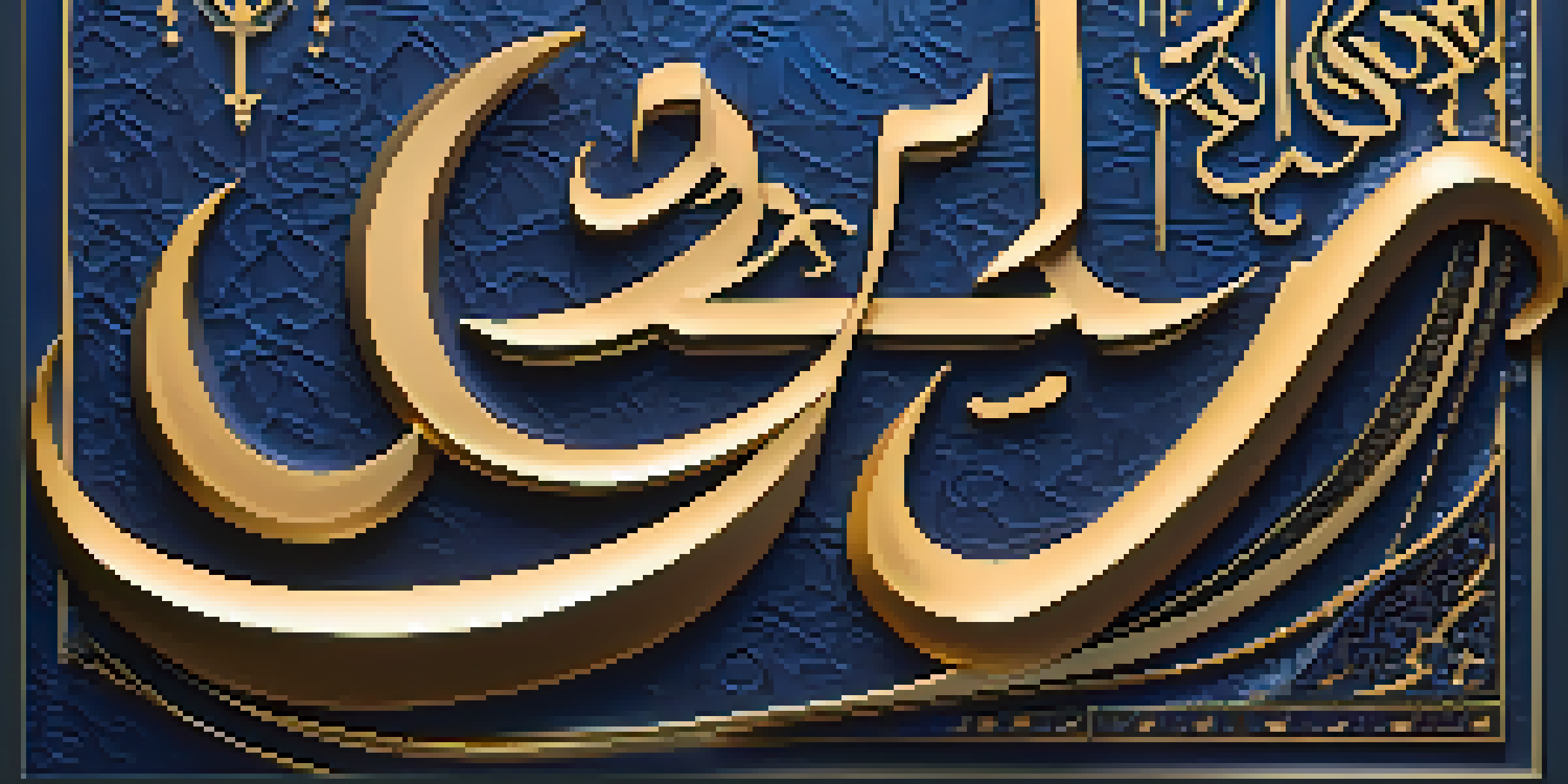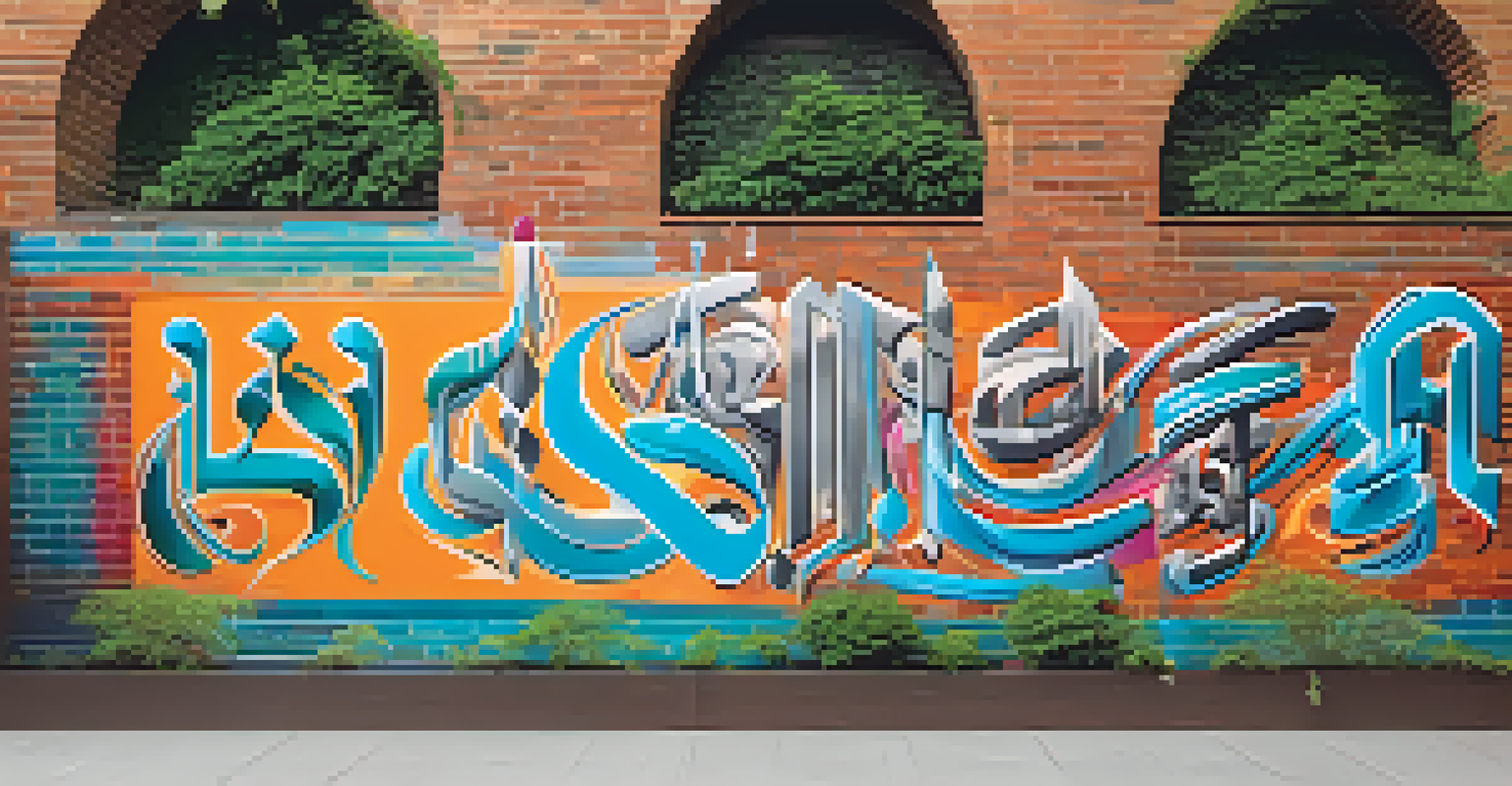The Role of Calligraphy in Islamic Art and Cultural Identity

Understanding Calligraphy: An Art Form Beyond Words
Calligraphy is often described as the art of beautiful writing, but in Islamic culture, it goes much deeper. It transcends mere aesthetics, embodying spiritual expression and cultural heritage. Each stroke of the pen is infused with meaning, making it a sacred act that connects the artist to their faith.
Calligraphy is a way of life, a form of meditation, and a pathway to the divine.
In the Islamic tradition, calligraphy is not just about creating visually appealing letters; it represents the divine. Many calligraphers view their work as a form of devotion, where the written word becomes an extension of spiritual beliefs. This intertwining of art and faith enriches the cultural landscape of Islamic societies.
Moreover, the meticulous nature of calligraphy reflects the values of patience and discipline, qualities cherished in many cultures. As artists invest hours honing their craft, they not only preserve a centuries-old tradition but also contribute to a living cultural dialogue that spans generations.
Historical Context: The Roots of Islamic Calligraphy
The origins of Islamic calligraphy trace back to the early days of Islam, where the written word was essential for preserving the Qur'an. As Islam spread across different regions, diverse styles of calligraphy emerged, each influenced by local cultures and artistic preferences. This evolution showcases the dynamic nature of Islamic art.

In places like Persia and the Ottoman Empire, calligraphy flourished, leading to the development of distinct styles such as Naskh and Diwani. Each style carries its own unique characteristics, allowing for a rich tapestry of visual language that communicates cultural identity. These styles not only serve practical purposes but also elevate the significance of the written word.
Calligraphy: Art Meets Spirituality
In Islamic culture, calligraphy transcends aesthetics, serving as a sacred expression of faith and cultural identity.
As a result, calligraphy became a vital form of artistic expression that transcended borders. It united various Islamic cultures while simultaneously allowing for regional differences, making it a remarkable example of how art can reflect both unity and diversity within a cultural context.
The Spiritual Dimension of Calligraphy in Islam
In Islamic culture, calligraphy serves as a spiritual bridge between the divine and the earthly realm. Many calligraphers draw inspiration from religious texts, transforming verses from the Qur'an into stunning visual art. This not only honors the sacred words but also invites viewers to engage with their spiritual significance.
In every stroke of the pen, there lies a story waiting to be told.
The act of writing becomes a meditative practice, allowing artists to immerse themselves in their faith. Each letter is crafted with intention, creating a profound connection between the calligrapher and their beliefs. This spiritual dimension elevates calligraphy beyond a mere art form; it becomes a means of worship.
Furthermore, calligraphy often adorns mosques and religious texts, reinforcing its role in Islamic worship. As people come into contact with these beautifully inscribed works, they are reminded of the divine presence and the importance of their faith, fostering a deeper cultural identity rooted in spirituality.
Calligraphy as a Reflection of Cultural Identity
Calligraphy is a powerful reflection of cultural identity within the Islamic world. It encapsulates the history, values, and traditions of various communities, allowing individuals to connect with their roots. Each style of calligraphy tells a story, revealing the unique characteristics of the culture from which it originates.
For instance, Maghribi calligraphy, prominent in North Africa, showcases a distinct flair that embodies the region's artistic heritage. Similarly, the elegant scripts of Ottoman calligraphy reflect the sophistication of the empire's cultural achievements. These differences highlight the rich diversity within Islamic art while reinforcing a shared identity.
Cultural Identity Through Calligraphy
Different styles of calligraphy reflect the diverse histories and traditions of various Islamic communities, reinforcing their cultural pride.
In contemporary times, calligraphy remains a vital element in expressing cultural pride. Artists continue to explore and innovate, blending traditional techniques with modern influences. This ongoing evolution ensures that calligraphy not only preserves the past but also resonates with future generations, keeping cultural identity alive and vibrant.
Calligraphy in Modern Islamic Art: A New Wave
The landscape of Islamic art is continually evolving, with calligraphy playing a central role in contemporary artistic expression. Modern artists are reinterpreting traditional styles, infusing them with innovative techniques and materials. This fusion of the old and new creates a dynamic dialogue that captivates audiences worldwide.
Digital technology has also transformed the way calligraphy is created and shared. Artists now have the tools to experiment with typography and design, reaching broader audiences through social media platforms. This accessibility fosters a renewed interest in calligraphy, inspiring a new generation to appreciate its beauty and significance.
As modern artists push boundaries, they also challenge perceptions of Islamic art, showcasing its relevance in today's world. This resurgence of calligraphy not only preserves its rich history but also invites a diverse audience to engage with its cultural significance, further enriching the artistic landscape.
The Educational Role of Calligraphy in Islamic Culture
Calligraphy is not just an art form; it serves as an educational tool within Islamic culture. Many schools and religious institutions incorporate calligraphy into their curricula, teaching students the techniques and history behind this revered practice. This educational approach helps preserve the tradition for future generations.
Through learning calligraphy, students gain insights into the cultural and spiritual values it embodies. They develop a sense of appreciation for the artistry involved, recognizing that each letter carries a deeper meaning. This understanding fosters a connection to their heritage and encourages them to carry the tradition forward.
Modern Evolution of Calligraphy
Contemporary artists are reinterpreting traditional calligraphy, using new techniques and digital tools to engage a broader audience.
Moreover, workshops and community classes promote calligraphy as a communal activity, bringing people together to share knowledge and creativity. These gatherings not only strengthen social bonds but also reinforce the importance of cultural identity in a rapidly changing world.
Global Influence: Calligraphy Beyond Islamic Borders
The beauty of Islamic calligraphy has transcended cultural boundaries, influencing artists around the globe. From Asia to Europe, the intricate designs and styles have inspired various art forms, showcasing the universal appeal of this ancient practice. It's fascinating to see how calligraphy resonates with diverse audiences.
For instance, contemporary artists in Western countries have embraced Islamic calligraphy, integrating it into their own works. This interaction fosters cross-cultural dialogue, promoting understanding and appreciation for Islamic art. Through exhibitions and collaborations, calligraphy continues to bridge cultural divides.

As global interest in calligraphy grows, it becomes a symbol of unity in diversity. By appreciating the artistry behind calligraphy, individuals from different backgrounds can connect with its rich history and significance, enriching the global cultural landscape in the process.